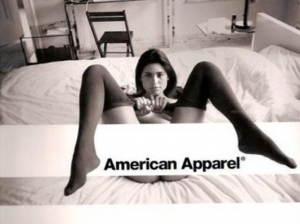I decided to analyse the American Apparel advertisement as I believe it is equally as shameful as the Duncan Quinn advert yet many would perceive the other to be worse. American Apparel have had many issues during their time running as a clothing company that eventually led to bankruptcy. The company itself was known for selling good quality clothing with positive ethical values for many years before these disturbing images were released.
The use of younger looking models was a common theme for them and could be seen as a way to promote a younger target market for this company – a clever promotional decision to boost sales. However when this is contrasted with raunchy imagery it sparks up ethical issues and morals in terms of underage connotations. The majority of the of the image is covered up to disguise the issue and perhaps get round the matter at hand but the open body language that is still on show promotes the idea of submission which on a legal front shouldn’t be shown at such a young age – “For at least some of the public, sexual ads represent a challenge to standards of decency and are in a real sense pornographic” (Pollay 1986, p. 28). The adverts themselves fail to focus on the promotion of the brand in terms of the clothing which could in tern have discourage customers to be seen wearing and promoting a brand that is linked to these negative associations. The company started off in 1990 with the selling of t-shirts under the American HEAVY label which is completely contrasted in this image in particular as the model is not seen to be wearing anything from the waist up. Back at the beginning of American Apparel the company proved to be to go to company for good quality, affordable clothing. As an added bonus it was well known that there was no human suffering involved in the production sector of the company stating this way of working would “give more ethical jobs to more people around the world” which had positive implications that could be a stand out feature for customers – they would feel like they were doing good by choosing to shopping there. However it then seemed that this gave them a free pass to produce sexually influenced imagery for the advertisement campaigns that left a bad taste in peoples mouth. It completely contrasted the positive values that the company spent so long building up. This unique selling point was also lowered in value when the younger generation valued cheaper clothing over the wellbeing of others which was the introduction of fast fashion. This I believe is where their issues started to arise as with a loss in sales started the shocking imagery which they most likely believed to be desirable imagery for their target audience. However it seemed that they over stepped the mark which in effect pushed away their customer base even more leading to them filing for bankruptcy in 2005.
Analysing the image itself further the use of black and white will add to the sense of seduction that is usually seen erotic films such as fifty shades of grey. Black itself is seen as a dominant colour with white being more innocent and pure so when put together in the right scenario this colour combination will make an image seem much more suggestive. The colour scheme also reduces factors such as colour distracting you which allows the viewer to focus on the detail in the image in much more detail which also making certain parts darker and less visible making it more delicate yet mysterious. The overall set up of the room relates to this more sexual theme that the company was trying to get across with the minimalistic look containing the plain background which due to increased negative space makes the viewer focus on the forefront imagery.
The Guardian. (2017). The new American Apparel: Claims of ‘ethically made’ abroad clash with reality. [online] Available at: https://www.theguardian.com/business/2017/nov/12/the-new-american-apparel-claims-of-ethically-made-abroad-clash-with-reality [Accessed 31 Nov. 2017].
Americanapparel.com. (2017) Ethically Made – Sweatshop Free | American Apparel. [online] Available at: http://www.americanapparel.com/en/ [Accessed 31 Nov. 2017]
Taylor & Francis. (2017) Ethics in Advertising: Ideological Correlates of Consumer Perceptions. [online] Avaliable at: http://www.tandfonline.com/doi/pdf/10.1080/00913367.1994.10673450?needAccess=true [Accessed 31 Nov. 2017].

